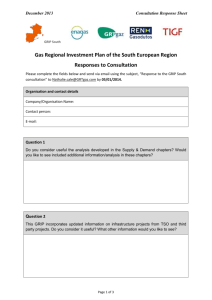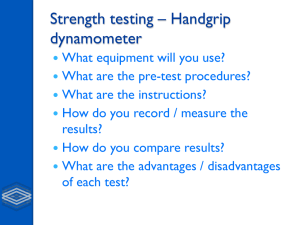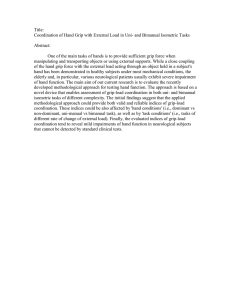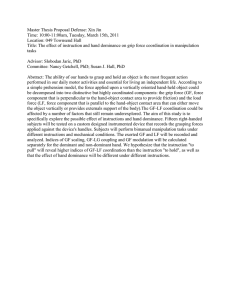Computing Parallel-Jaw Grip Points 0 ABSTRACT
advertisement
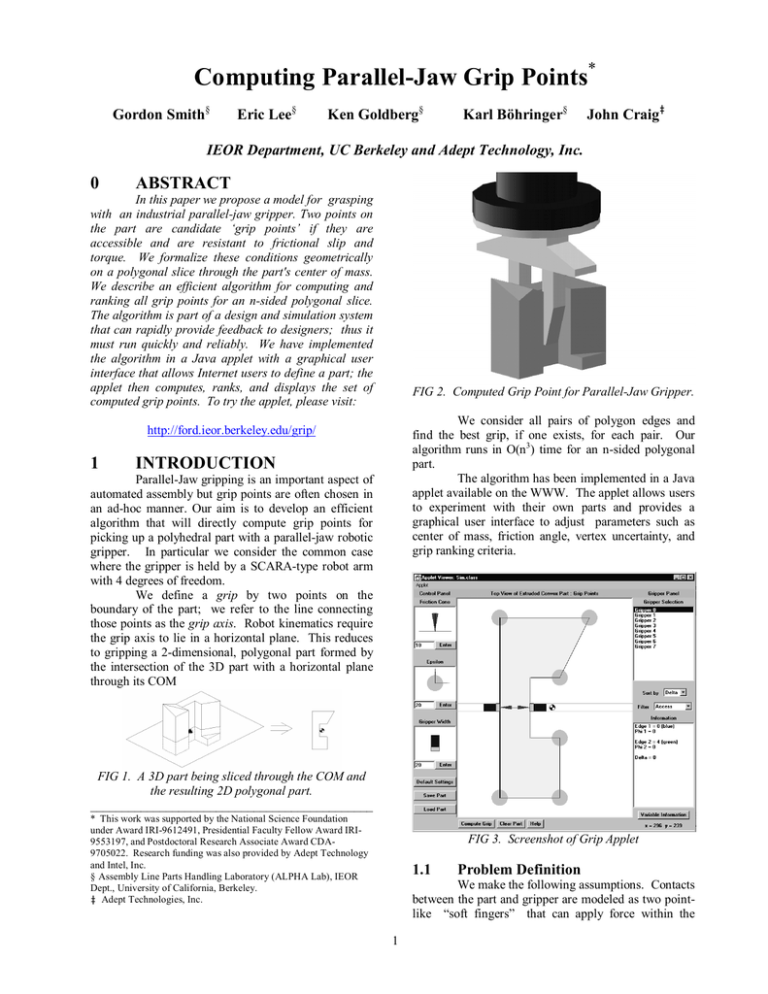
Computing Parallel-Jaw Grip Points* Gordon Smith§ Eric Lee§ Ken Goldberg§ Karl Böhringer§ John CraigÁ IEOR Department, UC Berkeley and Adept Technology, Inc. 0 ABSTRACT In this paper we propose a model for grasping with an industrial parallel-jaw gripper. Two points on the part are candidate ‘grip points’ if they are accessible and are resistant to frictional slip and torque. We formalize these conditions geometrically on a polygonal slice through the part's center of mass. We describe an efficient algorithm for computing and ranking all grip points for an n-sided polygonal slice. The algorithm is part of a design and simulation system that can rapidly provide feedback to designers; thus it must run quickly and reliably. We have implemented the algorithm in a Java applet with a graphical user interface that allows Internet users to define a part; the applet then computes, ranks, and displays the set of computed grip points. To try the applet, please visit: FIG 2. Computed Grip Point for Parallel-Jaw Gripper. We consider all pairs of polygon edges and find the best grip, if one exists, for each pair. Our algorithm runs in O(n3) time for an n-sided polygonal part. The algorithm has been implemented in a Java applet available on the WWW. The applet allows users to experiment with their own parts and provides a graphical user interface to adjust parameters such as center of mass, friction angle, vertex uncertainty, and grip ranking criteria. http://ford.ieor.berkeley.edu/grip/ 1 INTRODUCTION Parallel-Jaw gripping is an important aspect of automated assembly but grip points are often chosen in an ad-hoc manner. Our aim is to develop an efficient algorithm that will directly compute grip points for picking up a polyhedral part with a parallel-jaw robotic gripper. In particular we consider the common case where the gripper is held by a SCARA-type robot arm with 4 degrees of freedom. We define a grip by two points on the boundary of the part; we refer to the line connecting those points as the grip axis. Robot kinematics require the grip axis to lie in a horizontal plane. This reduces to gripping a 2-dimensional, polygonal part formed by the intersection of the 3D part with a horizontal plane through its COM FIG 1. A 3D part being sliced through the COM and the resulting 2D polygonal part. _____________________________________________ * This work was supported by the National Science Foundation under Award IRI-9612491, Presidential Faculty Fellow Award IRI9553197, and Postdoctoral Research Associate Award CDA9705022. Research funding was also provided by Adept Technology and Intel, Inc. § Assembly Line Parts Handling Laboratory (ALPHA Lab), IEOR Dept., University of California, Berkeley. Á Adept Technologies, Inc. FIG 3. Screenshot of Grip Applet 1.1 Problem Definition We make the following assumptions. Contacts between the part and gripper are modeled as two pointlike “soft fingers” that can apply force within the 1 friction cone at the point of contact and torque about the grip axis. In addition to gripping on edges we allow one or both of the grip points to be placed at a concave vertex if it will not slip. We will treat this situation analogously to gripping at edges by constructing a virtual edge with infinitesimal length at each concave vertex. For each virtual edge, we construct an effective friction cone that is the Minkowski sum of the friction cones of its neighboring edges as shown in Figure 4. The normal of the virtual edge is centered on the effective friction cone. 1.2 Related Work Space does not permit a thorough review of the robot gripping literature; for thorough reviews please see [1], [2], [3], [4], [5]. Mishra, Schwartz, and Sharir 87 show that 4 fingers are necessary for form closure of a 2D lamina. Nguyen 88, and Markenskoff and Papadimitriou 89, each develop algorithms to determine grip points to achieve form closure grips on a polygon with 4 frictionless fingers. When friction is introduced, Blake and Taylor [6] addressed the problem of determining optimum force closure grips on 2D smooth curves. They do so by determining local extrema of a friction function related to the angle between the grip axis and the part normal. Our criteria 2 and 3 are similar but we add consideration of accessibility and torque based on part COM. Mirtich and Canny [7] consider grasping polygonal parts and assume that rounded fingertips transform polygons to form a smooth curve. Their analysis leads to the criterion of finding the maximal chord, which, when applied to a polygonal part, finds grip points at opposing vertices. Montana [8] noted in their development of contact stability that this grip is inherently unstable to small perturbations or slippage. Nguyen 88 develops a model of soft fingers that we use for our gripper tips. Brost 91 shows how to generate the set of possible friction cones for vertexvertex intersections, which we adapt to model a gripper tip in contact with a concave vertex. Rao, Kreigman, and Goldberg [9] consider a related problem: determining grip points such that the part passively rotates to a new orientation when the part is lifted. Our grip model modifies and extends that model to define a class of grip points that also take accessibility into account. FIG 4. A virtual edge at a concave vertex. We use the following 5 criteria to define grip points: 1. Grip points should either lie on an edge at least a distance ε from any convex vertex or lie at a concave vertex. Grips near a convex vertex could fail due to small uncertainties in part or gripper orientation. 2. The grip axis should lie within the friction cone at each edge so that the tips do not slip with respect to the part. The friction cone is defined by the halfangle α, α=arctan(µ), where µ is the coefficient of friction. 3. The grip should have a minimal dependence on friction. 4. The grip should also minimize the amount of torque required to avoid rotation when the part is lifted. Torque is calculated by the cross product of the weight and the radius vector to the COM. Thus torque is proportional to δ, the distance from the grip axis to the COM. 5. Both grip points must be accessible to the gripper. A point is accessible if it is possible to reach the point from infinity in the approaching direction of the grip axis. A problem instance includes as input: a. The location of n part vertices and the COM in (x,y) coordinates. b. The friction angle α. c. The parameter, ε, which represents the radius of an uncertainty disk centered on each vertex. The output is all calculated grip points sorted by either frictional dependence or torque and the values δ, φj, and φk which quantify those criteria. The number of grips for a part can range from 0 to O(n2). For example an isosceles triangle with a friction cone angle less than 30o will have no grip points. 2 FIVE CRITERIA FOR GRIPS We consider each pair of polygon edges, ej and ek. Let I be the point where the two edges would intersect if they were extended. Construct a weighted bisector of the angle, βj,k, between edges ej and ek such that the angle between edge ej and the bisector is defined by: α j . (1) β γ j = α j + α k j,k The angle between edge ek and the bisector is defined by αk . (2) γ 2 k = α j +α k β j ,k In other words, the grip axis is the same fraction of the friction cone away from the normal for both edges. The intuitive case is two edges with the same friction cone angle and the grip should have the same angle at both faces. Also, when φ = 0 it is not possible to decrease φj without increasing φk. This is not true when φ > 0. Therefore the third criteria is φ = min. (6) FIG 5. A pair of edges, ej and ek, and the construction of the weighted bisector. 2.4 We can parameterize the grip points by their distance from I along the lines formed by the edges. We use sj for the distance along ej and sk along ek. 2.1 ε, radius of vertex uncertainty disks No grip point may be placed within a specified distance, ε, from any convex vertex. If an edge consists of all points from sj,start to sj,end then any grip point must satisfy (sj,start + ε) ≤ sj,grip ≤ (sj,end - ε) (3) This insures that the grip will not miss the specified edge due to uncertainties in part geometry and gripper orientation. 2.2 2.5 2.6 The graph of this function has contour lines, or iso-φ lines, that are radial with slopes cos( γ k ) − sin( γ k ) tan φ (9) m = Dependence on friction A grip should have the minimum dependence on friction. This is done by minimizing φj AND minimizing φk. In order to strike a balance between minimizing φj and φk we now define φ as the angle between the grip axis and the normal to the weighted bisector. We note that when φ = 0 the following is true: φj φ (5) = k j α Graphical Representation For any pair of grips we can consider the 2D space of grips defined by (sj,sk). Associated with each grip is a value of δ and a value of φ. It is therefore possible to determine φ=φ(sj,sk) and δ=δ(sj,sk). We omit the derivations for lack of space but give the equations below s j cos( γ j ) − s k cos( γ k ) . (8) φ = arctan s j sin( γ j ) + s k sin( γ k ) Friction cones α Accessibility Finally, we need to consider whether a pair of grip points can be reached by the gripper. We use a critical point analysis for edges within the convex hull to determine accessibility cones. These cones limit the grips considered to only those which are accessible. All grips should have a grip axis that lies within the friction cone of each edge. If φj is the angle between the normal to edge ej and the grip axis and φk is similarly defined then φj ≤ αj AND φk ≤ αk (4) This will prevent the part from slipping during gripping. 2.3 Torque We also want to minimize the amount of torque that the tips must provide when the part is lifted. The torque is weight times δ therefore minimum torque δ = min. (7) is ensured by cos( γ j ) + sin( γ j ) tan φ except for the case of two parallel edges in which case the contour lines are parallel. Note that the φ = 0 line has a slope of cos( γ k ) . (10) m = cos( γ j ) For calculating δ it is necessary to know the location of the COM. We will parameterize its location by D and L. D is the perpendicular distance from the weighted bisector and L is the distance along the weighted bisector. k δ = FIG 6 3 ( s j cos γ j − L )( s k sin γ k − D ) + ( s k cos γ k − L )( s j sin γ j + D ) [s j cos γ j − s k cos γ k ] + [s 2 j sin γ j + s k sin γ k ] 2 We can overlay the contour graphs of the two functions to allow us to take both friction and torque into consideration simultaneously. The first two criteria, ε and the friction cones, bound a region of grips that are possible. First, only the rectangular region satisfying (sj,start+ε) ≤ sj ≤ (sj,end-ε) AND (sk,start+ε) ≤ sk ≤ (sk,end-ε) is included. This region may be truncated by either or both of two φ lines that represent the edges of the friction cones. Those lines are defined by φ = φ = MIN(γj-αj , γk-αk). In MIN(γj+αj , γk+αk) and Pair of edges F riction tes t no Rejected pair of edges yes Candidate pair of edges Minimize friction and torque yes no Minimize friction Minimize torque Grip with minimum friction Grip with minimum torque Check acces sibility and adjust grip as necess ary Grip with minimum friction and torque Rejected pair of edges Best grip for pair Repeat for all pairs of edges All accessible, locally optimized grips S ort List of grip points for accessible, locally optimized grips sorted by friction or torque FIG 8 3.1 Friction Test For each edge pair we first run a short test to reject pairs that could not contain a grip. If the angle, β, between the edges ej and ek is greater than the sum of the friction cone angles for each edge, βj,k > (αj + αk), then no grip on this pair of edges can meet the friction criteria. In practice this significantly reduces the number of candidate pairs of edges. general the region of possible grips looks like this. FIG 7. The region of possible grips on the φ and δ contour graphs. The dependence on friction criteria and the torque criteria can indicate an optimum grip from the region of possible grips. However, these two criteria are not always in agreement therefore two separate optimizations can occur. One branch emphasizes friction, one emphasizes torque. When they do not yield the same result our algorithm performs both optimizations. 3 FIG 9. A part with n=4 has 6 pairs of edges but only 2 candidate pairs to be considered in the main algorithm. ALGORITHM Our algorithm uses basic geometry and simple conditional tests quickly determine grip points according to the criteria explained above. The algorithm runs in O(n3) time. The friction test runs in O(n2) time for the whole part. Then the grip points section runs in O(1) tine for each of the O(n2) pair of edges. Finally the accessibility section runs in O(n3) time for the part as a whole. The flow chart below outlines the basic operation. 3.2 Grip Points For each edge our objective is to determine the best pair of grip points. First, it is helpful to shrink ej and ek by ε at each end so that the entire length of the remaining edges meets the ε criteria. We use the term “endpoints” to refer to the new beginning and end to distinguish them from the vertices. 3.2.1 Minimizing Friction and Torque We first check whether there is a grip that minimizes both friction and torque or equivalently has δ = 0 AND φ = 0. Construct a line that goes through 4 the COM and is perpendicular to the weighted bisector. If this line intersects both edges then the intersections define grip points on the pair. FIG 12. a has φ =0 b has φ=min c has φ=min 3.2.3 Minimizing Torque We now determine the grip that minimizes the necessary torque provided by the gripper tips. First note that if there is not a friction minimizing grip then there is also not a torque minimizing grip. We will use the same critical edges and critical points defined earlier. We check for a grip with a grip axis through the COM and a critical point. If none exists then the δ = min grip has grip points at a critical point and an endpoint of the opposite edge. We check these possibilities and check that φj ≤ αj AND φk ≤ αk are satisfied. If not, we perturb the grip axis to have a direction that satisfies the friction criteria and check grips with that direction at each endpoint. One will be the δ = min grip. FIG 10 φ = 0 and δ = 0 Grip When the line fails to hit one or both edges then we must adjust this first attempt to meet all criteria. In general, at this point, it is possible to minimize either frictional dependence or torque but not both at the same time. We therefore determine two grips for the pair of edges. One grip has minimum friction and the other has minimum torque. Note that the minimum friction grip also has the least torque of all grips with that friction and similarly, the minimum torque grip has the least friction of all grip with that torque. 3.2.2 Minimizing Friction We first determine the grip that minimizes the dependence on friction. Define a “critical edge” as an edge not intersected by the line perpendicular to the bisector through the COM. Then define a “critical point” as the end point of the critical edge nearest to that line. FIG 13. a has δ=0 b has δ=min c hasδ=min within the friction cones 3.3 Accessibility Finally we check if a grip is accessible. A grip is accessible if both grip points are reachable from infinity in the direction of the grip axis. Extend the grip axis and check for intersections with edges of the part besides the candidate pair. This can be done in O(n) time for each grip. At this point it may seem simplest to eliminate any grip that is not accessible. We note, however, that it may be possible to perturb a grip to be sub-optimal but accessible. We therefore run an algorithm that perturbs the grip to the best accessible grip. The procedure runs at O(n3) for the part as a whole and in fact only needs to run when an optimal grip has failed the accessibility test. 3.3.1 Accessibility Cones First, find the convex hull of the part. Any grip failing the test must have one or both edges within a concavity. Within that concavity, find the set of all convex vertices and add the vertices of both edges of FIG 11. Critical Points and Edges We check for a grip with φ = 0 through a critical point. If none exists then the φ min grip has one grip point at a critical point and the other at one of the endpoints of the other edge. We check those possibilities to find φ = min then check that the criteria φj ≤ αj AND φk ≤ αk are met. If not then there is no grip for this pair of edges. 5 the candidate pair. Connect every pair of points in the set with a line. This operation yields at most one line from every vertex to every vertex in the part even when run for all candidate pairs and is therefore O(n2). Eliminate any line that does not intersect both edges in the candidate pair. Extend the lines and eliminate any line that intersects any edge besides the edges of the candidate pair. This is an O(n) operation for each line totaling O(n3) for the part. the grip axis of the accessible, friction minimizing grip is through the critical vertex of one of those accessibility cones and the COM. If the COM is in none then the nearest side of the nearest accessibility cones the grip axis of the accessible, torque minimizing grip. Note that it is possible that the algorithm finds no grips. 4 IMPLEMENTATION The implementation lets users define a part and visualize the grips generated. Java’s Abstract Windowing Toolkit (AWT) package provides various GUI components, such as buttons, menus, etc. Anyone with a Java-enabled browser can run and test the algorithm. The following sections describe the user interface and the runtime performance of the algorithm. 4.1 User Interface The user interface is designed so that parts and parameters can be intuitively defined and grips can be easily viewed. The Java applet is divided into three columns. The left column contains the control panel where the user can change the friction angle, ε, and the gripper’s width. These parameters take effect once the user clicks on the button labeled “Compute Grip” located at the bottom of the applet. The center column of the applet shows the polygonal slice of the part. It is the drawing area where the user can define new parts. It also gives a graphical representation of the grips generated by the algorithm. The right column contains a list of all the generated grips. The user can view each grip by clicking on an item in the list. Below that list is where relevant information about the current grip is given. FIG 14. a: Part, Convex Hull and Inaccessible Grip. b: Critical Vertices and Action Cones. c: Modified Action Cones, [1]Accessible φ=min Grip, and [2] Accessible δ=min Grip. The remaining pairs of lines form “accessibility cones”. A critical vertex and a range of angles characterize each accessibility cone. If a grip is to reach the edge at an angle that is within the range of angles of an accessibility cone then the critical vertex of that cone is the point that it must clear. Truncate each range of angles to include only those angles within the friction cones of both edges to form “modified accessibility cones”. If there are no remaining cones then there is no accessible grip for that pair of edges. We must again divide our consideration to both friction minimizing and torque minimizing grips. If the grip that failed the accessibility test was torque minimizing then only the torque optimization is run. Similarly for the friction minimizing grip. 3.3.2 Accessible and Friction Minimizing Grip Find the modified accessibility cones that include the angle φ = 0. There will be either two or zero. If there are two then the line with φ = 0 through the critical vertices of one of those cones is the grip axis of the accessible, friction minimizing grip. If there are zero then the edge of the accessibility cone with the minimum φ is the grip axis of the accessible, friction minimizing grip. 3.3.3 Accessible and Torque Minimizing Grip The COM either lies within zero or two modified accessibility cones. If it lies within two then 4.2 Performance Table 1 gives running time of the applet on an Intel Pentium Pro/200 running Symantec Visual Café's JVM. Table 1 Part Description 6 # of Vertices Running time (ms) # of Grips Generated 8 220 7 19 490 11 23 1270 22 35 2970 7 71 3890 14 5 CONCLUSION [9] We have presented an efficient algorithm for determining grip points for a 2D polygonal part. The algorithm finds local minima in frictional dependence and required torque while taking into account uncertainties and accessibility. The algorithm appears to be relatively robust to the challenging test cases provided by Internet users. We invite reviewers to try the applet for themselves. Currently we consider only the 2D polygon that passes through the part’s COM and we verify accessibility only in the grip plane. Further work is needed to identify the optimal slice of the 3D part and to check the accessibility of grip points when obstructions exist above or below the grip axis. The grip algorithm is being ported to C++ and will be included in a simulation package that aids in the rapid design, visualization, and programming of industrial assembly systems. 6 REFERENCES [1] R. A. Grupen, T.C. Henderson, and I. D. McCammon, “A Survey of General Purpose Manipulation”, in Int. J. of Robotics Research, Vol. 8(1), 1989 Jocelyn Pertin-Troccaz, “Grasping: a State of the Art”, in The Robotics Review I, pp. 71-98. MIT Press 1989, edited by O. Khatib, J. J. Craig, and T Lozano-Perez. J. Kenneth Salisbury, Kinematic and Force Analysis of Articulated Hands, PhD Thesis, Mept. of Mech. Engineering, Stanford University, May 1982, Published in Robot Hands and the Mechanics of Manipulation, MIT Press, 1985. B. Faverjon and J. Ponce, “On Computing Two-Finger Force-Closure Grasps of Curved 2D Objects”, in Int. Conf. of Robotics and Automation. IEEE, May 1991. A Blake, “Computational Modeling of HandEye Coordination”, Phil. Trans., Royal Society of London B, vol. 337, pp. 353-360, 1992. Andrew Blake and Michael Taylor, “Planning Planar Grasps of Smooth Contours”, in International Conference on Robotics and Automation, IEEE, May 1993. Brian Mirtich and John Canny, “Easily Computable Optimum Grasps in 2-D and 3D”, in International Conference on Robotics and Automation, IEEE, May 1994. David J. Montana, “Contact Stability for TwoFingered Grasps”, in Transactions on Robotics [2] [3] [4] [5] [6] [7] [8] [10] [11] [12] [13] 7 and Automation, IEEE, Vol. 8, No. 4, August 1992. Anil Rao, David Kriegman, and Ken Goldberg, “Complete Algorithms for Feeding Polyhedral Parts using Pivot Grasps”, in Trans. on Robotics and Automation, IEEE, April 1995. Van-Duc Nguyen, “Constructing Stable Grasps”, in The International Journal of Robotics Research, Vol. 8, No. 1, February 1989. Van-Duc Nguyen. “Constructing Force Closure Grasps”, in The International Journal of Robotics Research, Vol. 7, No. 3, June 1988. Xanthippi Markenscoff and Christos H. Papadimitriou, “Optimum Grip of a Polygon”, in The International Journal of Robotics Research, Vol. 8, No. 2, April 1989. Xanthippi Markenscoff, Lugun Ni, and Christos H. PapadimitriouThe Geometry of Grasping”, in The International Journal of Robotics Research, Vol. 9, No. 1, April 1989.
